Hot working of metals refers to a metal forming process that is performed at elevated temperatures, typically above the recrystallization temperature of the metal. The main objective of hot working is to shape the metal into desired forms with minimal residual stress and improved ductility. This process is in contrast to cold working, where deformation is performed at room temperature or below the recrystallization temperature, which results in higher strength but reduced ductility.
In hot working, the metal becomes more malleable and easier to deform, allowing for significant shaping without the risk of cracking or fracture. The elevated temperature softens the material, causing recrystallization, which leads to the formation of new grains and the elimination of strain-hardening effects. Common hot working techniques include hot rolling, hot forging, hot extrusion, and hot drawing. These methods are widely used in various industries, such as automotive, aerospace, construction, and manufacturing, to produce a wide range of products, from sheets and plates to complex shapes and components.
One of the key advantages of hot working is the ability to produce large components with homogeneous microstructures, improved mechanical properties, and reduced anisotropy. The process allows for higher deformation rates and lower required forces compared to cold working, making it more efficient for large-scale production. However, hot working does have its limitations. It is not suitable for all metals, as some materials may be prone to excessive oxidation or thermal degradation at elevated temperatures. Additionally, the cost of energy and equipment required for hot working can be higher than for cold working processes.
Introduction to Hot Working of Metals: Definition and Purpose
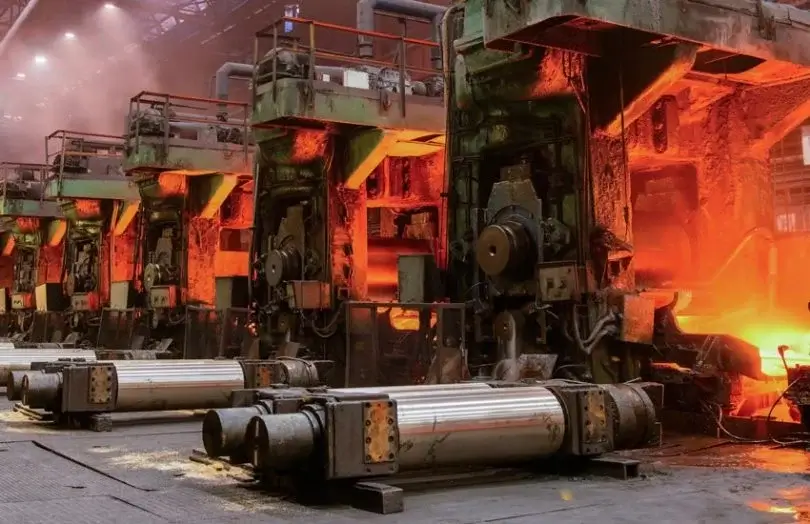
Introduction to Hot Working of Metals: Definition and Purpose
Hot working of metals is a fundamental metalworking process that involves shaping and forming metals at elevated temperatures. Unlike cold working, where deformation is carried out at room temperature, hot working takes advantage of the metal’s improved ductility and reduced strength at high temperatures. The critical temperature range for hot working is typically above the recrystallization temperature of the metal, where the material undergoes recrystallization, leading to the formation of new, strain-free grains.
The purpose of hot working is to achieve specific shapes and dimensions in the metal while minimizing the risk of cracks or fractures during the forming process. By heating the metal to its appropriate working temperature, it becomes more malleable and easier to deform, allowing for substantial changes in shape without compromising its integrity. This process is commonly employed in the production of various metal components, such as sheets, plates, bars, and complex geometries in industries like manufacturing, construction, aerospace, and automotive. Hot working is particularly advantageous for producing large quantities of components with uniform mechanical properties, as it results in better grain structure and enhanced mechanical performance compared to cold working techniques.
The Significance of Elevated Temperatures: Effects on Metal Properties
Elevated temperatures play a crucial role in hot working of metals as they significantly influence the material properties during the forming process. When a metal is heated above its recrystallization temperature, several important effects come into play:
- Improved Ductility: One of the most significant advantages of hot working is the increased ductility of metals at elevated temperatures. Ductility refers to the ability of a material to undergo plastic deformation without fracturing. When the metal is heated, the atomic bonds become weaker, allowing the material to undergo large deformations and take on new shapes without failure. This enhanced ductility is essential for forming intricate and complex components through processes like hot rolling, hot forging, and hot extrusion.
- Recrystallization and Grain Refinement: At elevated temperatures, recrystallization occurs in the metal, leading to the formation of new, strain-free grains. During cold working, metals can become work-hardened and develop dislocations, which can make the material brittle. However, in hot working, recrystallization erases the previous deformation history, creating a more refined grain structure. This results in improved mechanical properties, including higher toughness, reduced anisotropy, and better overall homogeneity of the metal.
- Reduced Flow Stress: The flow stress of a material refers to the force required to cause plastic deformation. When a metal is heated, its flow stress decreases significantly, making it easier to shape and form. As a result, hot working processes require lower forces and energy compared to cold working techniques, making hot working more efficient for large-scale production.
Overall, elevated temperatures play a vital role in hot working by enhancing the metal’s ductility, promoting recrystallization and grain refinement, and reducing flow stress. These effects allow for the production of high-quality metal components with improved mechanical properties and better manufacturability, making hot working a critical process in various industrial applications.
Hot Working vs. Cold Working: Contrasting Methods and Benefits
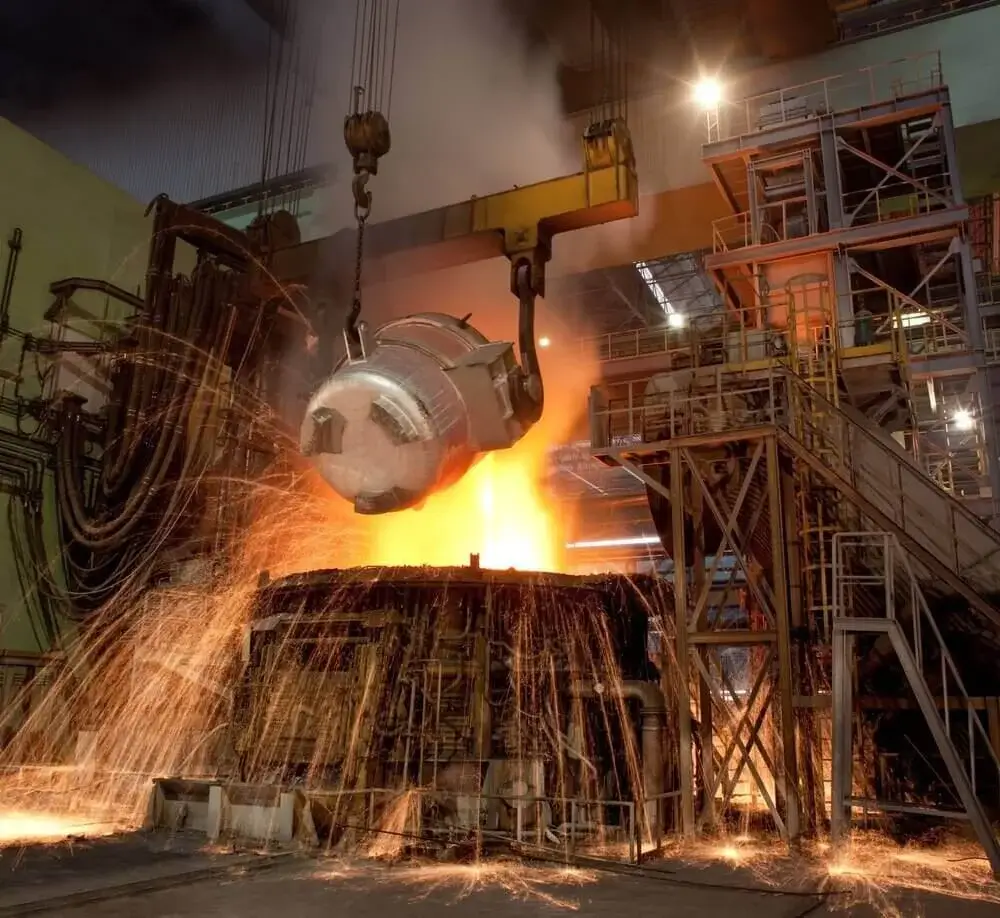
Hot Working vs. Cold Working: Contrasting Methods and Benefits
Hot working and cold working are two contrasting methods of metal forming, each offering distinct benefits and applications:
Temperature and Deformation Conditions: The primary difference between hot working and cold working lies in the temperature at which the metal is formed. Hot working is carried out at elevated temperatures above the recrystallization temperature of the metal, typically in the range of 50% to 80% of its melting point. This high temperature softens the metal, making it more malleable and easier to deform. In contrast, cold working is performed at room temperature or below the recrystallization temperature, where the material is harder and less ductile. Cold working techniques, such as cold rolling and cold drawing, lead to increased strength and hardness but reduce ductility.
Material Properties and Applications: Hot working is ideal for shaping large metal components and producing complex geometries with minimal risk of cracking or fracture. It improves the material’s ductility, refines grain structure through recrystallization, and reduces residual stresses. This makes hot working suitable for manufacturing components such as sheets, plates, rails, and large structural sections used in construction and heavy machinery. On the other hand, cold working processes result in higher strength and improved dimensional accuracy, making it well-suited for producing precision components, such as wires, tubes, and precision tools. Cold working is commonly employed in the automotive industry for manufacturing vehicle components, such as engine parts and body panels.
Efficiency and Energy Consumption: Hot working generally requires lower forces and energy compared to cold working. The softening effect of elevated temperatures reduces the resistance to deformation, making the process more efficient for large-scale production of bulk materials. However, hot working can cause oxidation and scale formation on the metal surface, requiring additional surface treatments. Cold working, while more energy-intensive, can be performed without the need for additional surface treatments, resulting in cost savings in certain applications.
Hot working and cold working are two distinct metal forming methods with unique advantages. Hot working provides improved ductility and allows for the production of large components with superior mechanical properties, while cold working yields higher strength and precision for smaller components. The choice between hot and cold working depends on the material’s characteristics, desired properties of the final product, and the specific application requirements.
Hot Working Techniques: Forging, Rolling, Extrusion, and more
Hot working techniques encompass a range of metal forming processes performed at elevated temperatures to shape and mold metals into desired forms. Some of the prominent hot working techniques include:
Forging: Hot forging involves the application of compressive forces to a heated metal billet, causing plastic deformation and reshaping the material into the desired shape. This process is commonly used to produce components with excellent mechanical properties and structural integrity, such as crankshafts, connecting rods, and gears for the automotive and aerospace industries.
Rolling: Hot rolling is a widely employed technique for shaping metals into various flat or long products, such as sheets, plates, bars, and rails. The process involves passing heated metal through a series of rollers, which apply compressive forces to reduce the material’s thickness or change its cross-sectional shape. Hot rolling enhances the mechanical properties of the metal and improves its surface finish.
Extrusion: Hot extrusion is a process that forms complex shapes by forcing heated metal through a die. The metal is pressed through the die’s shaped opening, resulting in the metal taking on the same profile as the die. Hot extrusion is commonly used to produce tubes, rods, and profiles with high strength and excellent dimensional accuracy.
Hot Drawing: Hot drawing, also known as hot drawing or hot working of wire, is used to produce wires and rods with reduced diameters by pulling them through a heated die. The process refines the grain structure, resulting in improved mechanical properties and a smooth surface finish.
Hot Spinning: Hot spinning is a metal forming process where a heated metal blank is rotated at high speeds while being formed over a mandrel or a mold. This technique is commonly used for shaping conical or curved components, such as kitchen utensils, lighting fixtures, and satellite dishes.
These hot working techniques are essential in various industries for producing a wide range of metal components with improved mechanical properties, better surface finish, and enhanced dimensional accuracy. The choice of the appropriate hot working method depends on factors such as the metal’s properties, desired final product specifications, and the complexity of the component’s shape.
Forging: Using Heat and Pressure to Shape Metals
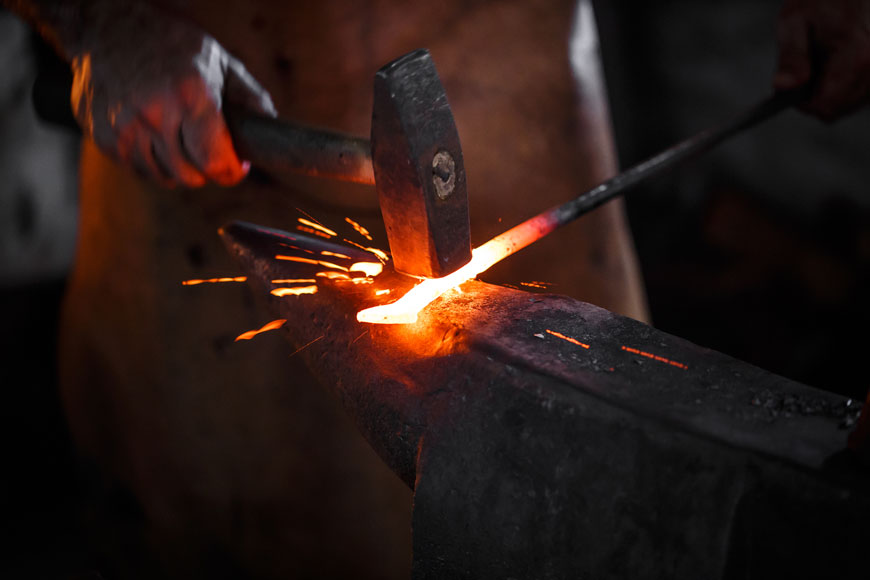
Forging: Using Heat and Pressure to Shape Metals
Forging is a traditional and widely used hot working process that involves the use of heat and pressure to shape metals into specific forms. In this method, a metal billet is heated to a temperature above its recrystallization temperature but below its melting point. The heated billet is then placed onto a die or an anvil, and compressive forces are applied using a hammer or a press. The pressure deforms the metal, causing it to take the shape of the die or anvil.
Forging is a highly versatile technique that allows for the production of components with excellent mechanical properties and structural integrity. The process refines the grain structure of the metal, eliminating any defects or voids that might be present in the raw material. This results in enhanced strength, toughness, and fatigue resistance of the forged component. Due to the controlled and gradual deformation, forging imparts directional strength to the metal, making it particularly suitable for critical applications where strength is essential.
There are various forging methods, including open-die forging, closed-die forging, and upset forging, each with its specific advantages and applications. Forging is commonly used in industries such as automotive, aerospace, oil and gas, and construction to produce components like crankshafts, connecting rods, gears, turbine blades, and structural parts. Its ability to create high-quality, reliable components has made forging an indispensable part of modern manufacturing processes.
Rolling: Reducing Thickness and Modifying Grain Structure
Rolling is a key hot working process used to shape metals by reducing their thickness or modifying their cross-sectional area while they are in a heated and malleable state. The process involves passing the heated metal through a series of rollers, which apply compressive forces in a controlled manner. As the metal is compressed between the rollers, its thickness is reduced, and it takes on the shape of the rollers. Rolling is widely employed in the production of flat and long products, such as sheets, plates, bars, and rails.
One of the significant benefits of rolling is the refinement of the metal’s grain structure. As the metal is subjected to mechanical deformation during rolling, new grains form, and existing ones are elongated and aligned along the rolling direction. This results in an elongated grain structure, which enhances the mechanical properties of the metal, such as improved strength, ductility, and toughness. The controlled deformation during rolling also helps to eliminate defects and impurities, leading to a more homogeneous and defect-free material.
Rolling is an efficient and cost-effective process, making it a crucial method in metalworking industries. The process can be used for both hot rolling and cold rolling, depending on the desired properties of the final product. Hot rolling is typically preferred for metals that require significant plastic deformation, while cold rolling is employed for materials that require improved surface finish, dimensional accuracy, and higher strength. Overall, rolling is a versatile technique that not only reduces the thickness of metals but also significantly improves their mechanical properties through grain refinement and defect elimination.
Extrusion: Forming Complex Cross-Sections with Heat
Extrusion is a hot working process used to form metals into complex cross-sectional shapes by applying heat and pressure to a heated metal billet. In this technique, the metal billet is preheated to a temperature above its recrystallization temperature, making it more malleable and easier to deform. The heated billet is then forced through a specially designed die, which imparts the desired shape to the metal. The die consists of a hollow cavity with a profile matching the desired cross-section of the final product.
Extrusion is a highly versatile process that allows for the production of various shapes, such as tubes, rods, channels, and other intricate profiles. The continuous and controlled flow of the metal through the die ensures consistent cross-sectional shapes with excellent dimensional accuracy. This method is particularly advantageous for producing long components with uniform cross-sections, reducing the need for additional machining operations.
Extruded components offer several benefits, including enhanced mechanical properties due to the improved grain structure resulting from the hot working process. Additionally, extrusion can be used with a wide range of materials, including metals and some non-metals like polymers. It finds applications in various industries, such as construction, automotive, aerospace, and electronics, where complex and uniform cross-sectional shapes are required for components and structures. Overall, extrusion is an essential hot working technique that enables the efficient production of components with intricate and consistent cross-sections, making it a vital part of modern manufacturing processes.
Hot Drawing and Hot Spinning: Specialized Hot Working Methods
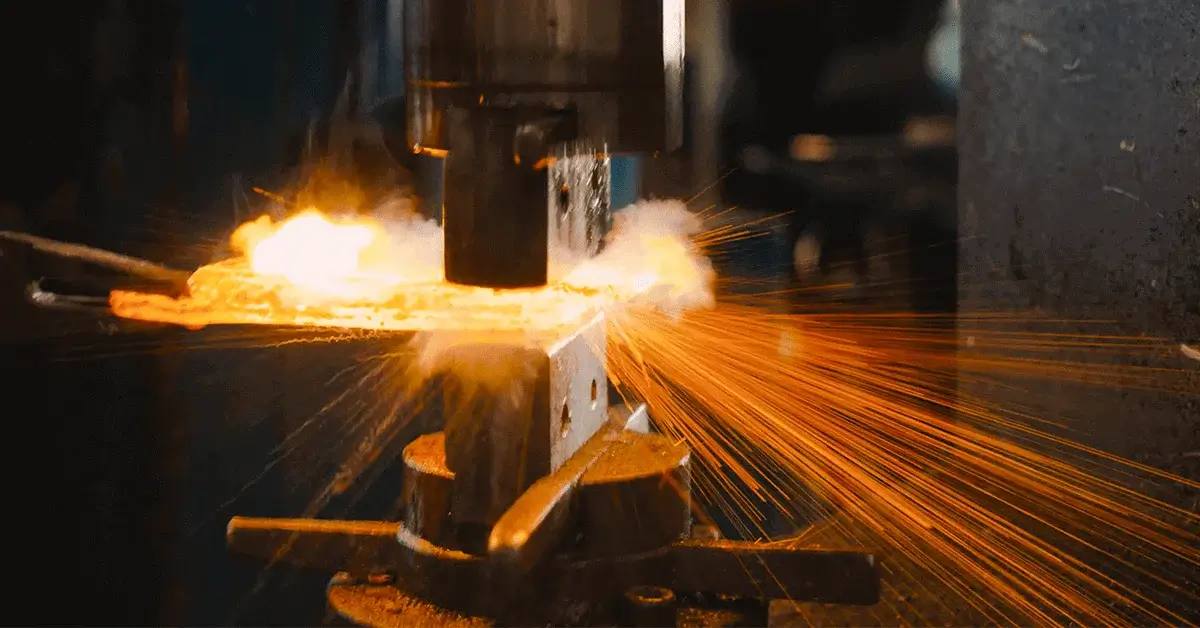
Hot Drawing and Hot Spinning: Specialized Hot Working Methods
Hot drawing and hot spinning are specialized hot working methods used to shape metals into specific forms, each with its unique applications and advantages.
Hot Drawing: Hot drawing, also known as hot drawing or hot working of wire, is a process used to reduce the diameter of a heated metal rod or wire by pulling it through a heated die. The metal is drawn through the die using tensile forces, and as it passes through the die’s opening, it takes on the desired reduced diameter. Hot drawing is commonly used to produce wires and rods with precise dimensions, improved surface finish, and enhanced mechanical properties. The process refines the grain structure of the metal, resulting in improved strength, ductility, and toughness. Hot drawing is extensively utilized in the manufacturing of various products, such as electrical wires, cables, fasteners, and precision components.
Hot Spinning: Hot spinning, also referred to as hot forming or hot metal spinning, is a metalworking process used to shape heated metal sheets or blanks into conical or curved shapes. The technique involves rotating the heated metal blank at high speeds while pressing it against a mandrel or a mold. The centrifugal force and pressure cause the metal to take on the shape of the mold, resulting in components with precise geometries and smooth finishes. Hot spinning is commonly used in the production of kitchen utensils, lighting fixtures, satellite dishes, and other products that require seamless and symmetrical curved shapes.
Both hot drawing and hot spinning leverage the benefits of hot working, such as improved ductility and grain refinement, to create components with enhanced mechanical properties and high-quality finishes. These specialized hot working methods play critical roles in various industries, enabling the efficient production of a wide range of products that meet strict dimensional tolerances and performance requirements.
Advantages of Hot Working: Improved Ductility and Homogeneity
Hot working offers several key advantages, with two prominent ones being improved ductility and homogeneity of the metal.
Improved Ductility: Heating the metal to elevated temperatures above its recrystallization temperature significantly increases its ductility. Ductility refers to the ability of a material to undergo plastic deformation without fracturing or breaking. When a metal is heated during hot working, the atomic bonds become weaker, allowing the material to undergo extensive deformation without the risk of failure. This enhanced ductility is crucial for shaping metals into complex forms and intricate geometries without encountering cracks or fractures. Hot working processes like hot rolling, hot forging, and hot extrusion take advantage of this increased ductility to produce a wide range of components with different shapes and sizes.
Homogeneity of the Metal: Hot working promotes the formation of a more homogeneous microstructure within the metal. During the hot working process, recrystallization occurs, which leads to the formation of new grains and the elimination of dislocations and strain-hardening effects that might have been present in the raw material. This recrystallization results in a finer, more uniform grain structure, making the metal more consistent and isotropic in its properties. A homogeneous microstructure translates to improved mechanical properties, including better strength, toughness, and fatigue resistance. This makes hot worked components more reliable and less prone to failure under mechanical stresses.
Hot working’s advantages lie in the improved ductility and homogeneity of the metal. The ability to deform metals at elevated temperatures allows for the production of complex shapes and intricate components, while the recrystallization process results in a more refined grain structure, leading to superior mechanical properties. These benefits make hot working a crucial metal forming process used in various industries, ranging from automotive and aerospace to construction and manufacturing.
Temperature Considerations: Determining the Appropriate Range
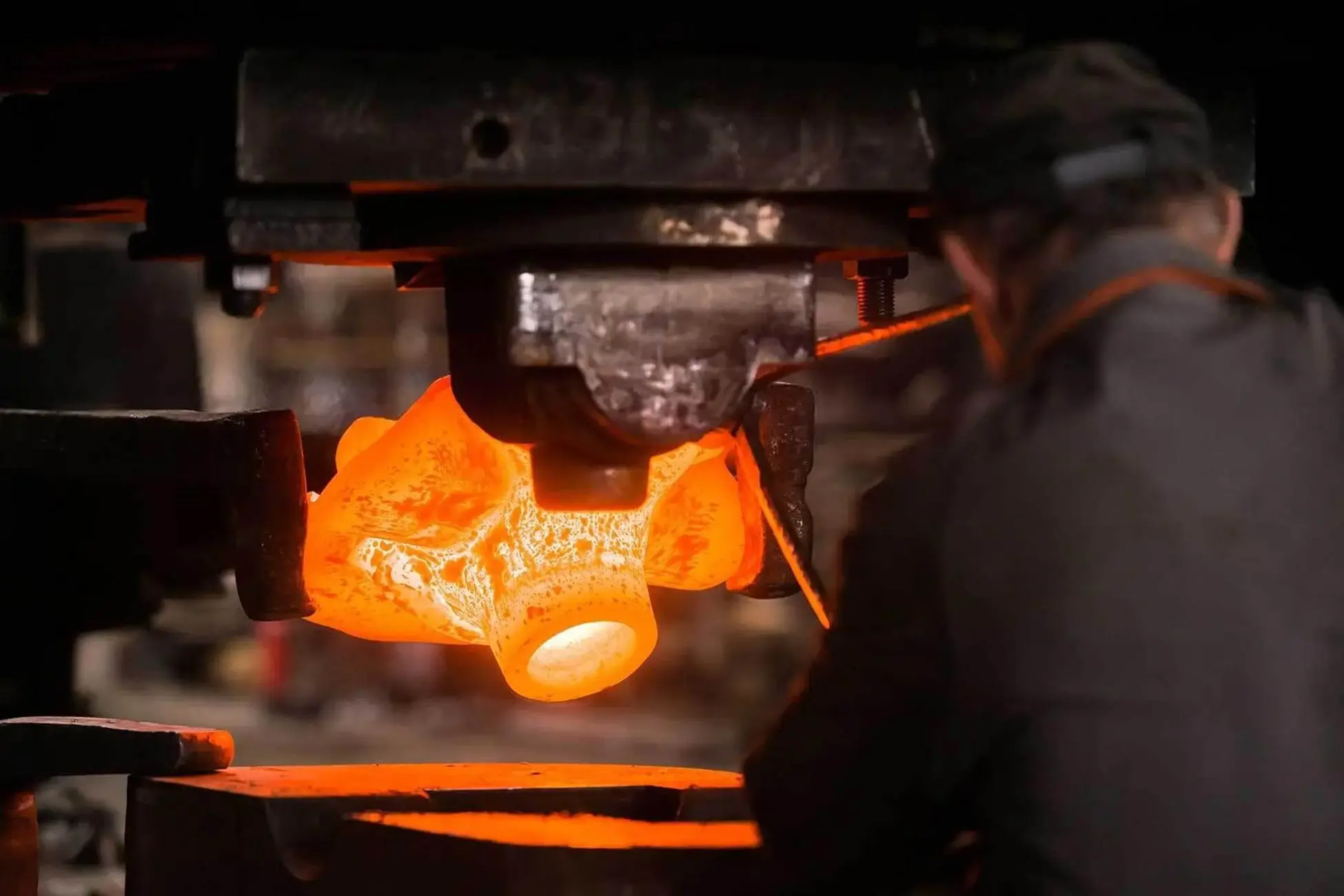
Temperature Considerations: Determining the Appropriate Range
Temperature considerations are crucial in hot working processes, as the appropriate temperature range directly impacts the material’s behavior and the quality of the final product. The temperature chosen for hot working is typically above the recrystallization temperature of the metal but below its melting point. The recrystallization temperature is the point at which the material undergoes complete recrystallization, leading to the formation of new, strain-free grains.
Selecting the correct temperature range is essential to ensure improved ductility, reduced flow stress, and better grain refinement during hot working. If the temperature is too low, the metal’s ductility may not be sufficient for effective deformation, leading to potential cracking or fractures during shaping. On the other hand, excessively high temperatures can result in undesirable grain growth, reducing the mechanical properties of the final product. Therefore, the temperature should be carefully controlled to strike a balance between achieving the desired plasticity and preventing excessive grain growth.
Various factors influence the choice of the appropriate temperature range, such as the type of metal, its composition, and the specific hot working process being used. Different metals have different recrystallization temperatures, so it’s essential to consider the material’s properties and behavior during hot working. Additionally, specific applications may require certain mechanical properties, which can be optimized by adjusting the hot working temperature. Overall, precise temperature control is critical in hot working to ensure optimal deformation, grain refinement, and the production of high-quality components with enhanced mechanical properties.
Heating Methods: Furnaces and Induction Heating in Hot Working
In hot working processes, heating methods play a vital role in bringing the metal to the appropriate temperature for deformation. Two commonly used heating methods are furnaces and induction heating.
Furnaces: Furnaces are widely used in hot working operations for heating metals to the desired temperature range. These are enclosed structures that provide controlled and uniform heating. There are various types of furnaces, including gas-fired furnaces, electric resistance furnaces, and induction furnaces. Gas-fired furnaces use natural gas or propane as a fuel source, while electric resistance furnaces use electric heating elements to generate heat. In both cases, the metal is placed inside the furnace and heated gradually to the required temperature. Furnaces are preferred for batch processing and are commonly used in industries where precise temperature control and large-scale heating are required.
Induction Heating: Induction heating is another popular method for heating metals during hot working. It utilizes electromagnetic induction to heat the metal directly. An induction coil generates alternating electromagnetic fields, which induce eddy currents in the metal, causing it to heat up rapidly. Induction heating offers several advantages, including high heating efficiency, rapid heating rates, and precise temperature control. It is particularly suitable for localized heating of specific areas, making it ideal for selective heating in processes like induction forging and induction hardening.
Both furnaces and induction heating are effective in bringing metals to the desired temperature for hot working. The choice between these methods depends on factors such as the type of metal being processed, the required heating rate, the size and shape of the components, and the level of temperature control needed for the specific hot working process. Proper heating is crucial to achieving the desired material properties, ensuring successful deformation, and producing high-quality components in hot working operations.
Hot Working Equipment: Presses, Hammers, and Rolling Mills
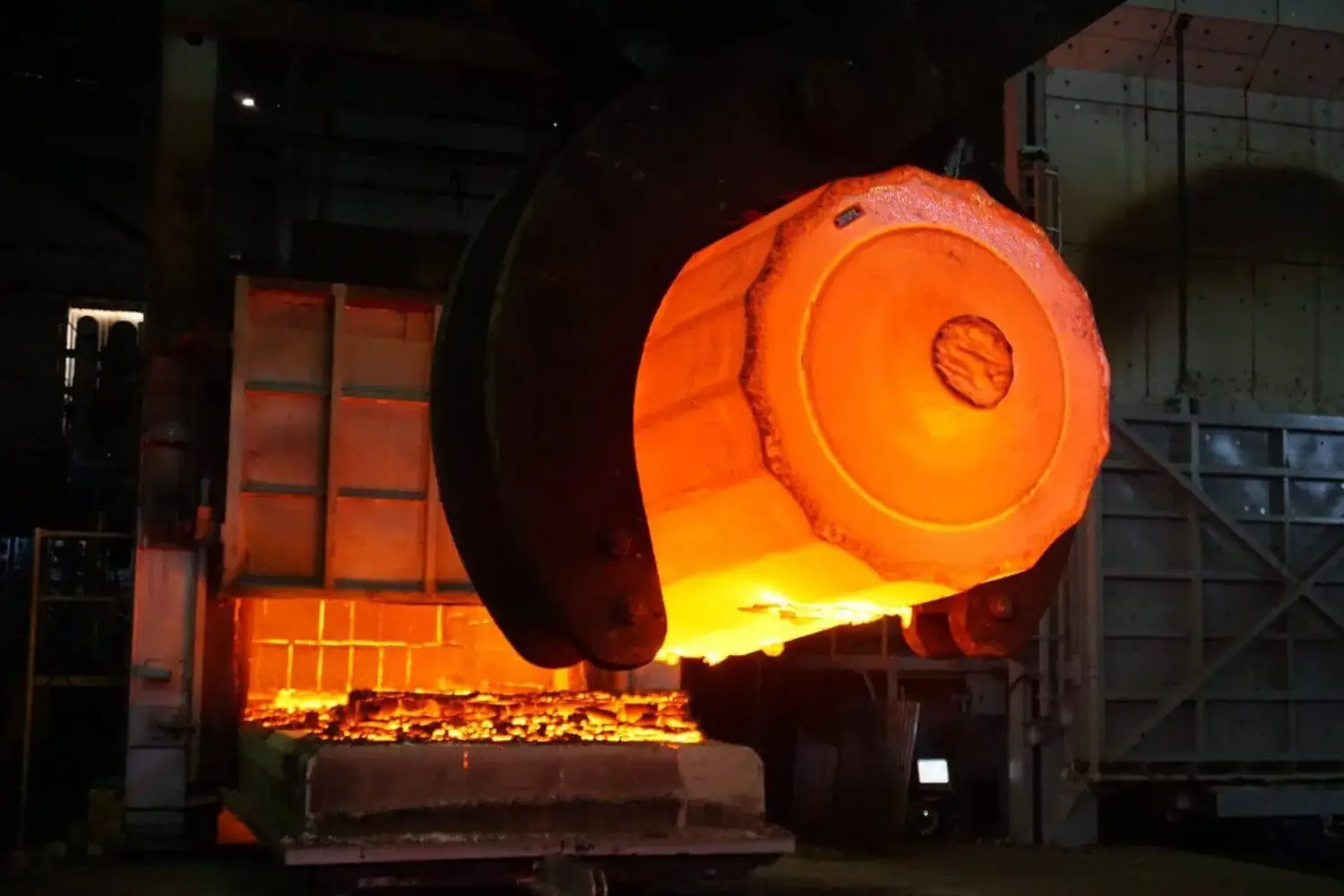
Hot Working Equipment: Presses, Hammers, and Rolling Mills
Hot working equipment comprises a variety of machinery and tools designed to deform metals at elevated temperatures. Three common types of hot working equipment are presses, hammers, and rolling mills.
Presses: Hot working presses are machines used to apply compressive forces to shape heated metal billets or ingots into desired forms. These presses can be hydraulic, mechanical, or electric, and they offer different capacities and capabilities. Hydraulic presses provide high force and flexibility, making them suitable for a wide range of hot working processes. Mechanical presses use flywheels or mechanical linkages to apply force, while electric presses utilize electric motors for power. Hot working presses are essential in processes such as hot forging, hot extrusion, and hot drawing, allowing for accurate and controlled deformation of metals into various shapes and components.
Hammers: Hot working hammers, also known as forging hammers, are machines used to deliver impact forces to the heated metal to shape it through plastic deformation. These hammers come in various types, including drop hammers and power hammers. Drop hammers use gravity to deliver a single, powerful blow to the metal, while power hammers use compressed air or steam to provide repeated blows. The repetitive impact of the hammer reshapes the metal and is commonly used in blacksmithing, hot forging, and open-die forging processes.
Rolling Mills: Hot rolling mills are specialized machinery used in the hot rolling process to reduce the thickness or modify the cross-sectional area of the heated metal. These mills consist of a series of rollers through which the metal is passed to achieve the desired shape and dimensions. Hot rolling mills are particularly important in the production of sheets, plates, bars, and rails, providing a controlled and continuous deformation of the metal to create uniform cross-sectional shapes with excellent mechanical properties.
These hot working equipment types are crucial in various metalworking industries, enabling the efficient and precise deformation of metals at elevated temperatures. The use of presses, hammers, and rolling mills ensures the production of high-quality components with improved mechanical properties and dimensional accuracy in hot working processes.
Workpiece Preparation: Preheating and Scaling Removal
Workpiece preparation is a critical step in hot working processes to ensure the efficient and successful deformation of metals. Two essential aspects of workpiece preparation are preheating and scaling removal.
Preheating: Preheating involves heating the workpiece to a specific temperature before starting the hot working process. The purpose of preheating is to bring the metal closer to its ideal working temperature, where it becomes more malleable and easier to deform. By preheating, the metal’s initial hardness is reduced, minimizing the risk of cracking or fracturing during the forming process. Preheating is particularly crucial for metals that have a high recrystallization temperature or are challenging to deform at room temperature. The uniformity of preheating is essential to ensure consistent and controlled deformation throughout the workpiece.
Scaling Removal: Scaling is the formation of oxide layers on the metal’s surface due to exposure to high temperatures. These oxide layers, also known as scale, can negatively impact the metal’s properties and surface quality. Before hot working, it is essential to remove the scale to ensure a clean and smooth surface for effective deformation. Scaling removal can be achieved through various methods, such as mechanical descaling using brushes or abrasive materials, chemical descaling with pickling solutions, or thermal descaling using high-temperature furnaces. Removing scale allows for better metal-to-die contact during hot working, reducing the risk of defects and surface imperfections in the final product.
Proper workpiece preparation, including preheating and scaling removal, is crucial to ensuring successful hot working processes. Preheating allows the metal to reach an optimal working temperature, improving its ductility and reducing the risk of defects. Meanwhile, scaling removal ensures a clean and smooth surface, enhancing the metal’s contact with the die and ensuring high-quality finished components. These preparatory steps contribute to the overall efficiency, quality, and reliability of hot working operations in various industries.
Hot Working Alloys: Impact of Composition on Processability
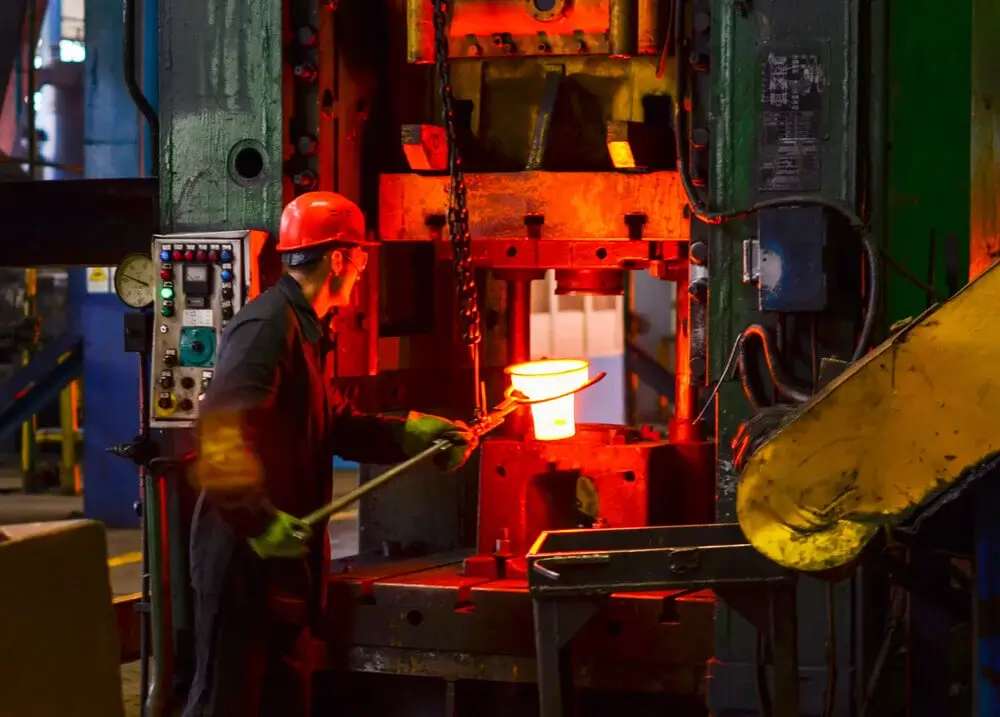
Hot Working Alloys: Impact of Composition on Processability
The composition of alloys has a significant impact on their processability during hot working. Different elements and their concentrations in the alloy can influence its behavior at elevated temperatures, affecting factors such as ductility, flow stress, recrystallization temperature, and susceptibility to oxidation.
- Ductility: Alloy composition plays a crucial role in determining the ductility of the material during hot working. Elements that promote solid solution strengthening or form intermetallic compounds can reduce the material’s ductility, making it more challenging to deform. On the other hand, elements that promote grain boundary sliding or enhance grain refinement can improve ductility, making the alloy more suitable for hot working processes.
- Flow Stress: The flow stress of an alloy is the resistance to plastic deformation. Alloy composition directly influences the flow stress during hot working. For instance, elements like carbon, nitrogen, and alloying elements can increase the flow stress and make the alloy more difficult to deform. In contrast, certain alloying elements, such as aluminum, magnesium, and copper, can lower the flow stress and improve the material’s formability.
- Recrystallization Temperature: The recrystallization temperature is the temperature at which new, strain-free grains form during hot working. The composition of the alloy can significantly affect this temperature. For example, alloying elements that retard or accelerate recrystallization can impact the material’s behavior during hot working, influencing the optimal temperature range for forming.
- Oxidation Resistance: Some alloying elements can improve the alloy’s resistance to oxidation at elevated temperatures. Alloys with higher oxidation resistance are less susceptible to surface scale formation during hot working, reducing the need for scaling removal processes.
The composition of alloys has a profound impact on their processability during hot working. The right alloy composition can enhance ductility, reduce flow stress, influence recrystallization behavior, and improve oxidation resistance, making the material more suitable for specific hot working processes and ensuring the production of high-quality components. Understanding the relationship between alloy composition and processability is crucial for selecting the appropriate materials and optimizing the hot working operations in various industries.
Applications of Hot Working: Industries and Product Examples
Hot working finds wide-ranging applications in various industries due to its ability to shape metals at elevated temperatures, resulting in improved formability and mechanical properties. Some of the prominent industries and product examples where hot working is extensively utilized are:
Automotive Industry: Hot working plays a crucial role in the automotive sector for manufacturing various components such as engine parts (crankshafts, camshafts, connecting rods), suspension components (control arms, knuckles), and transmission parts. For instance, hot forging is used to produce strong and lightweight connecting rods, while hot rolling is employed to manufacture high-strength steel sheets for car body panels.
Aerospace Industry: In aerospace applications, hot working is used to produce critical components like turbine blades and engine casings. The hot working processes, such as hot extrusion and hot forging, enable the production of complex shapes with superior mechanical properties and enhanced performance at high temperatures.
Construction Industry: Hot working is extensively used in the construction industry for manufacturing structural sections, beams, columns, and rails. Hot rolling is employed to produce steel plates and sections with precise dimensions and mechanical properties, ensuring the structural integrity of buildings, bridges, and other infrastructures.
Manufacturing Industry: Hot working is employed in various manufacturing processes to create a wide array of products. For example, hot extrusion is used to produce aluminum and copper profiles for electrical components, while hot spinning is employed to shape kitchen utensils, lighting fixtures, and decorative items.
Oil and Gas Industry: In the oil and gas sector, hot working is used to produce high-strength and corrosion-resistant components for pipelines, valves, and drilling equipment. Hot forging is utilized to create durable and reliable components that can withstand the harsh and demanding conditions in the oil and gas exploration and production processes.
Overall, hot working is a critical metal forming process with a broad spectrum of applications across industries. Its ability to shape metals at elevated temperatures leads to the production of high-quality components with improved mechanical properties, making it a vital technique for various manufacturing sectors.
Challenges and Limitations: Handling High Temperatures and Oxidation
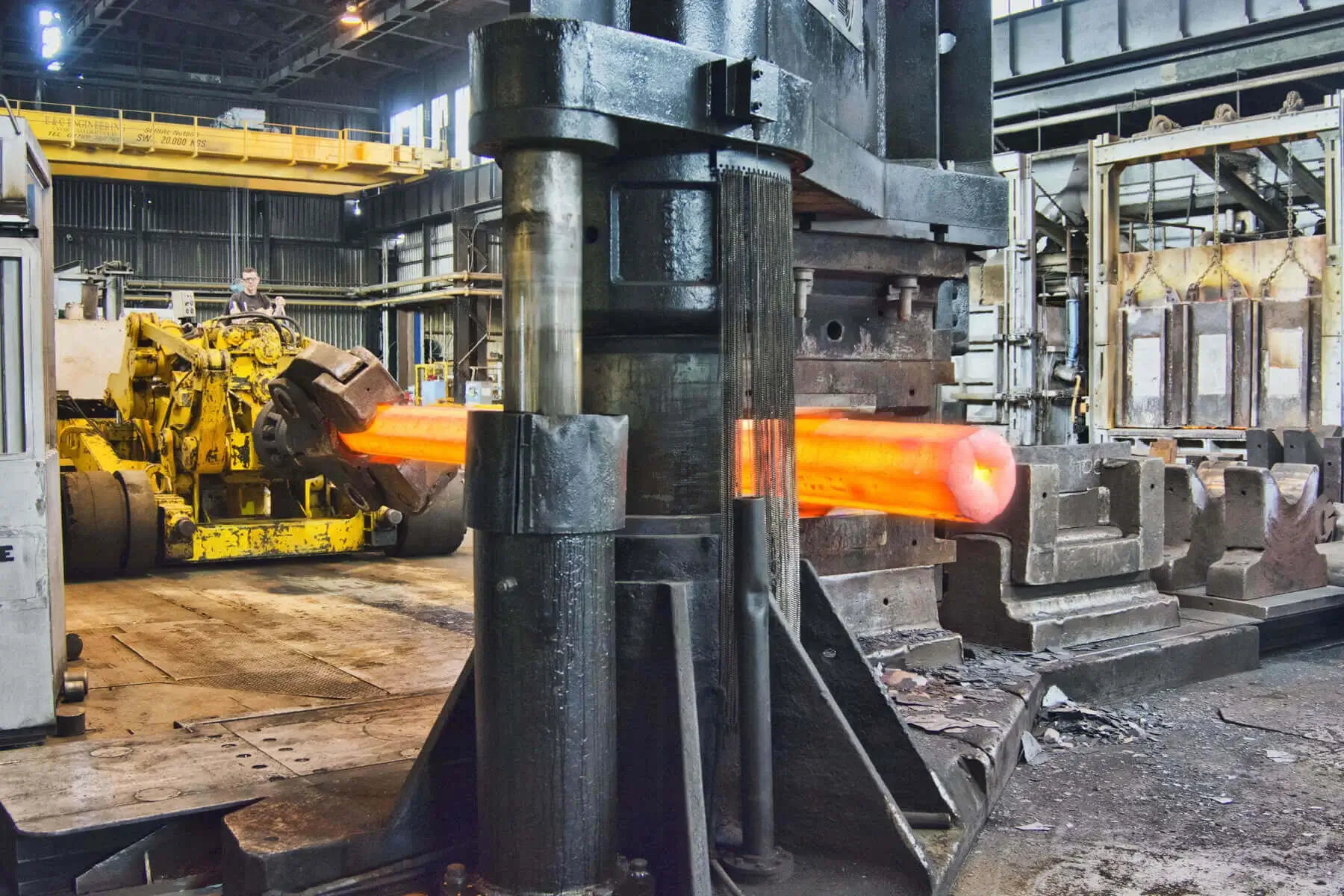
Challenges and Limitations: Handling High Temperatures and Oxidation
Hot working is a crucial metal forming process with several advantages, including improved ductility, refined grain structure, and the ability to create complex shapes. However, it also comes with its set of challenges and limitations. One of the primary challenges is the risk of metallurgical defects that can occur during hot working. Issues such as centerline segregation, porosity, and surface cracking may arise due to improper temperature control, inadequate material preparation, or insufficient deformation control. These defects can compromise the mechanical properties and structural integrity of the final product, making careful process optimization and quality control essential.
Another limitation of hot working is its energy-intensive nature. The process requires significant energy inputs to heat the metal to elevated temperatures. The high temperatures involved can also result in thermal stresses and warping of the workpiece, affecting dimensional accuracy and requiring subsequent machining or additional processing steps to achieve the desired final dimensions. Managing energy consumption and minimizing material waste are critical considerations in hot working processes to ensure economic viability and environmental sustainability.
Furthermore, some metals and alloys may exhibit poor hot workability due to their composition or microstructure. Certain materials may be prone to grain growth, excessive oxidation, or sensitivity to deformation temperature, making hot working impractical or challenging. In such cases, alternative processing techniques like cold working or warm working may be preferred. Selecting the most appropriate metal forming method for a particular material is crucial to achieving the desired product quality and efficiency in manufacturing. Despite these challenges and limitations, hot working remains an indispensable process in various industries, offering unique advantages that lead to the production of a wide range of high-performance components and structures.
Quality Control in Hot Working: Ensuring Consistent Results
Quality control is of utmost importance in hot working processes to ensure consistent and reliable results. Proper quality control measures help prevent defects, maintain dimensional accuracy, and produce components with desired mechanical properties. Here are some key aspects of quality control in hot working:
Temperature Control: Temperature is a critical parameter in hot working. Proper temperature control is essential to achieve the desired material properties and formability. Monitoring and maintaining the correct heating temperature of the workpiece throughout the hot working process is crucial to avoid issues like underheating or overheating, which can lead to improper grain refinement, inadequate ductility, and cracking. Advanced temperature monitoring systems and feedback mechanisms can be employed to ensure precise temperature control.
Die Design and Maintenance: The design and condition of the dies used in hot working significantly influence the quality of the final product. Well-designed dies help ensure uniform deformation, minimize defects, and maintain dimensional accuracy. Regular maintenance and inspection of dies are crucial to avoid wear and deformation, which can negatively impact the component’s surface finish and overall quality. Die cooling systems may also be employed to manage temperature variations during the forming process and maintain dimensional stability.
Material Inspection: Thorough inspection of the raw material before hot working is essential to identify any potential defects or impurities. Material testing methods, such as spectroscopy, microstructure analysis, and mechanical testing, can help ensure that the material meets the required specifications. Any non-conforming materials should be identified and removed from the production process to prevent defects in the final product.
Defect Detection and Remediation: In-process inspections, such as visual inspections, ultrasonic testing, or eddy current testing, can help detect defects during hot working. Rapid identification of defects allows for immediate remediation measures, such as adjusting process parameters, revising die designs, or adjusting temperature controls, to minimize the impact on product quality.
By implementing robust quality control measures, manufacturers can achieve consistent and reliable results in hot working processes. Ensuring proper temperature control, die maintenance, material inspection, and defect detection contributes to producing high-quality components with improved mechanical properties and surface finish, meeting the stringent requirements of various industries.
Safety Precautions: Dealing with Hot Metals and Equipment

Safety Precautions: Dealing with Hot Metals and Equipment
Handling hot metals and equipment during hot working processes requires strict adherence to safety precautions to protect workers from potential hazards. Essential safety measures include providing workers with appropriate Personal Protective Equipment (PPE) such as heat-resistant gloves, safety glasses, face shields, and heat-resistant clothing. PPE helps protect workers from burns, splashes, and other injuries caused by contact with hot metals or equipment. Insulated gloves are particularly crucial for handling hot materials, tools, or dies.
Proper training and education are essential for all personnel involved in hot working processes. Workers should be familiar with the specific hazards associated with hot working, understand the safety protocols, and know how to operate equipment safely. They should also be trained in emergency response procedures, such as what to do in case of a fire, equipment malfunction, or injuries. Regular inspection and maintenance of hot working equipment are crucial to ensure its safe operation. Faulty or damaged equipment can pose serious safety risks, so a proactive maintenance schedule is necessary to identify and address any issues promptly.
Adequate ventilation is essential in hot working areas to control heat, fumes, and airborne particles, reducing the risk of heat-related illnesses, fume inhalation, and exposure to harmful substances emitted during hot working processes. Heat shields and insulating materials should be installed around hot working equipment and workstations to minimize the risk of accidental burns and exposure to hot surfaces, creating a safer working environment. Hot working areas should be equipped with fire extinguishers and first aid stations, and workers should be trained in first aid techniques to handle injuries in case of an accident.
By implementing these safety precautions, employers can ensure a safe working environment in hot working facilities, mitigating potential hazards and reducing the risk of accidents and injuries. The safety and well-being of workers should always be a top priority in any industrial setting, especially when dealing with high temperatures and potentially hazardous materials.
You can review the products obtained after the processes on the Finemetal website.

